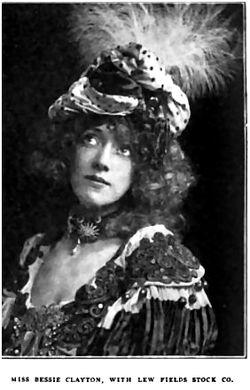Bessie Clayton
Bessie Clayton | |
|---|---|
 The Hampton's Broadway Magazine October, 1904 | |
| Born | c. 1875 |
| Died | July 16, 1948 (aged 72–73) |
| Occupation(s) | Dancer, choreographer |
| Spouse(s) | Julian Mitchell (divorced); 1 child Bert Cooper |
Bessie Clayton (c. 1875 – July 16, 1948)[1][2][3] was an American Broadway, vaudeville and burlesque specialty dancer and choreographer whose near 35-year career began in the era popularly known as the "Gay Nineties". Clayton was remembered for her whirlwind style of dance often performed while descending a long flight of stairs. She is considered to be the matriarch of American toe-tap dancing,[4] and the melding of stage dancing and classical ballet.[5][6] In her obituary, The New York Times called Clayton America’s first native-born prima ballerina.[2]
Biography
The daughter of Edward and Elizabeth Clayton, Irish immigrants, Bessie Clayton was born in Philadelphia, sometime in the 1870s, where she received her early instruction from the ballet master, George Washington Smith (1820–1899).[2][7][8] She first performed on stage at around the age of eight and with help of a fellow Philadelphian, composer and manager Alfred E. Aarons, made her professional debut some eight years later in Charles Hoyt's long-running hit musical, A Trip to Chinatown staged at New York's Madison Square Theatre.[9] Reportedly, Clayton was hired as a temporary one night fill-in after dancer Loie Fuller abruptly left the cast of A Trip to Chinatown. The diminutive dancer (5’1” as an adult) so impressed Hoyt’s company they employed her for the following six seasons.[2][10]
On May 23, 1894, Clayton married Hoyt’s choreographer, Julian Mitchell. The couple remained together until 1910, but did not divorce until December 1923.[3] They had one child, a daughter, Priscilla, who married Roger Pryor, the son of bandleader Arthur Pryor, in 1926. They had a daughter around five years later. They divorced in 1934. Roger Pryor, also a bandleader like his father, later became a Hollywood actor and wed actress Ann Sothern.[2][11]
Not long after their marriage. Clayton and Mitchell sailed for England where on June 25, 1894, she made her debut engagement there at London's Lyric Theatre[12] followed a few weeks later with engagements in Paris. Over their time together Clayton and Mitchell often worked together in Charles Hoyt's productions and later with Joe Weber and Lew Fields, with whom she performed in nearly all of their shows. Between 1898 and 1913 Clayton appeared in a string of mostly successful Broadway productions.[13] She was the premier danseuse in the Ziegfeld Follies of 1909,[10] and spent the remainder of her career performing on Broadway or with her own company touring various vaudeville circuits.[2]
Clayton retired in 1924 and married her former manager, Bert Cooper (1882–1945). A resident of West Long Branch, New Jersey, where she lived with her granddaughter, Clayton died in 1948 at Hazard Hospital, Long Branch.[2]
From Vaudeville, Old and New by Frank Cullen[14]
What a marvelous whirl of energy is Bessie Clayton. Her suppleness and absolute control [of] muscle and the lightning speed of her movements leave one gasping. She is here, there and everywhere, and always buoyant, light-hearted, inconsequential and full of that restless, tireless nervous energy that animates so much of American life. - Caroline Caffin, author of Vaudeville: the Book, (1914)
Clayton's vibrancy inspired the song "Bessie, My Right Hand Bower", with music by Gus Edwards and lyrics by Will D. Cobb. The song begins:
Ever seen a 'rora borealis? Or a pyrotechnical display? Ever seen a Princess in a Palace, Shine so bright you turn your face away?
Then put your peepers on a little lady, Smoke your glasses so that you can see, And feast your eyes upon the fairest, rarest, Brightest bit of femininity.
See also
References
- ^ Note: Approximate birth year based on press reports that Clayton was 19 when she first married in May, 1894 and not yet 20 when she performed in Europe later that summer.
- ^ a b c d e f g "Miss Bessie Clayton, Retired Ballerina", The New York Times, July 17, 1948, p. 15. Accessed October 25, 2015. "Surviving are a daughter, Mrs. Andrew Allison, former wife of Roger Pryor, movie actor and band leader, and a granddaughter, Priscilla Mitchell Pryor, with whom she lived at West Long Branch."
- ^ a b Bessie Clayton Divorced, The New York Times, January 1, 1924, p. 4
- ^ Toe-tap dancing is a style of tap-dancing performed on tip toes.
- ^ Shields, David S. "Bessie Clayton". Broadway Photographs. Retrieved January 24, 2020.
- ^ Stewart, Bob. "Weber and Fields: When Burlesque Meant Burlesque". goingplaces.streetcarmysteries.com. Retrieved August 8, 2023.
- ^ "Toetap History". justtoetapping.blogspot.com. Retrieved April 25, 2013.
- ^ Craine, Debra; Mackrell, Judith (January 1, 2010). "Smith, George Washington". The Oxford Dictionary of Dance. Oxford University Press. doi:10.1093/acref/9780199563449.001.0001. ISBN 978-0-19-956344-9.
- ^ Who's Who on the Stage, (Aarons, Alfred E.), 1908. Accessed April 25, 2013.
- ^ a b Little Dancer Wears Tiny Shoes, The Indianapolis Star, February 27, 1910, p. 36
- ^ Ann Sothern: a Bio-Bibliography, 1990, p. 5. Accessed April 27, 2013.
- ^ Condensed Cablegrams, The New York Times, June 26, 1894, p. 5
- ^ Internet Broadway Database - Bessie Clayton. Accessed April 27, 2013.
- ^ Cullen, Frank, Vaudeville, Old and New - 2003 - p. 236. Accessed April 27, 2013.
- ^ "Bessie, My Right Hand Bower". Accessed 8 August 2023.
